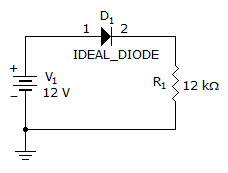Electronics - Diodes and Applications - Discussion
Discussion Forum : Diodes and Applications - General Questions (Q.No. 16)
16.
What is the current through the diode?


Discussion:
26 comments Page 1 of 3.
Geetanjali said:
7 years ago
According to ohms law,
I = V/R.
So,
I=12/12000.
= 0.001A.
that is, 1ma.
I = V/R.
So,
I=12/12000.
= 0.001A.
that is, 1ma.
(1)
Ayush sharma said:
1 decade ago
In case of ideal diode in forward bias voltage drop is 0.
Hence I= V/R.
I=12/12k.
=1mA.
Hence I= V/R.
I=12/12k.
=1mA.
Jefferson said:
4 years ago
Ideal means perfect.
So 0.7v is disregard.
We only account 0.7v in dealing 2nd approximation. The first approximation is the ideal approximation so I=V/R.
So 0.7v is disregard.
We only account 0.7v in dealing 2nd approximation. The first approximation is the ideal approximation so I=V/R.
Piyush mishra said:
5 years ago
Here in the circuit, the diode in the circuit is an ideal diode so No voltage drop in the diode.
So,
Current I = V/R = 12/12k(12000) = 0.001 A or 1 mA.
So,
Current I = V/R = 12/12k(12000) = 0.001 A or 1 mA.
Shadan said:
8 years ago
Ideally, a diode would act like a short circuit (0V across it) if it was conducting current. When a diode is conducting current it's forward biased (electronics jargon for "on"). The current-voltage relationship of an ideal diode. Any negative voltage produces zero current " an open circuit.
ADJEI MENSAH PRINCE said:
9 years ago
THE DIODE IS IDEAL AND HENCE HAS NO VOLTAGE DROP, except for cases where it is framed as a silicon diode with voltage drop of 0.7 so, in this case, using Kirchoff's voltage law,
VT=V1+V2 VT=V2 where v1=0 from V=IR I=V/R.
I=12/12000 I=0.001.
I=1mA.
VT=V1+V2 VT=V2 where v1=0 from V=IR I=V/R.
I=12/12000 I=0.001.
I=1mA.
Siddharth Chaitanya said:
9 years ago
In series current across every resistor in a branch is remains same in an ideal case. The diode is forward biased acts like conductor so current across resistor equal to the current across the diode.
Current accross resister is 12/12k=1mA.
Current accross resister is 12/12k=1mA.
Himanshu said:
9 years ago
V = IR.
12 = I * 12000.
I = 12/12000.
I = 1mA.
IN IDEAL DIODE, THERE IS NO VOLTAGE DROP DOWN.
12 = I * 12000.
I = 12/12000.
I = 1mA.
IN IDEAL DIODE, THERE IS NO VOLTAGE DROP DOWN.
Imran said:
9 years ago
As they haven't mentioned about diodes condition whether it is ideal or not.
so,assuming;
1) diode as ideal = drop will be 0v,
Hence answer = 1mA.
2) diode as practical(non-ideal) = drop will be 0.7 for silicon diode.
Hence answer = 0.942mA.
so,assuming;
1) diode as ideal = drop will be 0v,
Hence answer = 1mA.
2) diode as practical(non-ideal) = drop will be 0.7 for silicon diode.
Hence answer = 0.942mA.
Mohammed Arif Rana said:
1 decade ago
We will assume diode as ideal because there is no specify that it is Si or Ge.
So I = v/r, given v=12v & r=12K.
I = 12v/12k = 1mA.
So I = v/r, given v=12v & r=12K.
I = 12v/12k = 1mA.
Post your comments here:
Quick links
Quantitative Aptitude
Verbal (English)
Reasoning
Programming
Interview
Placement Papers